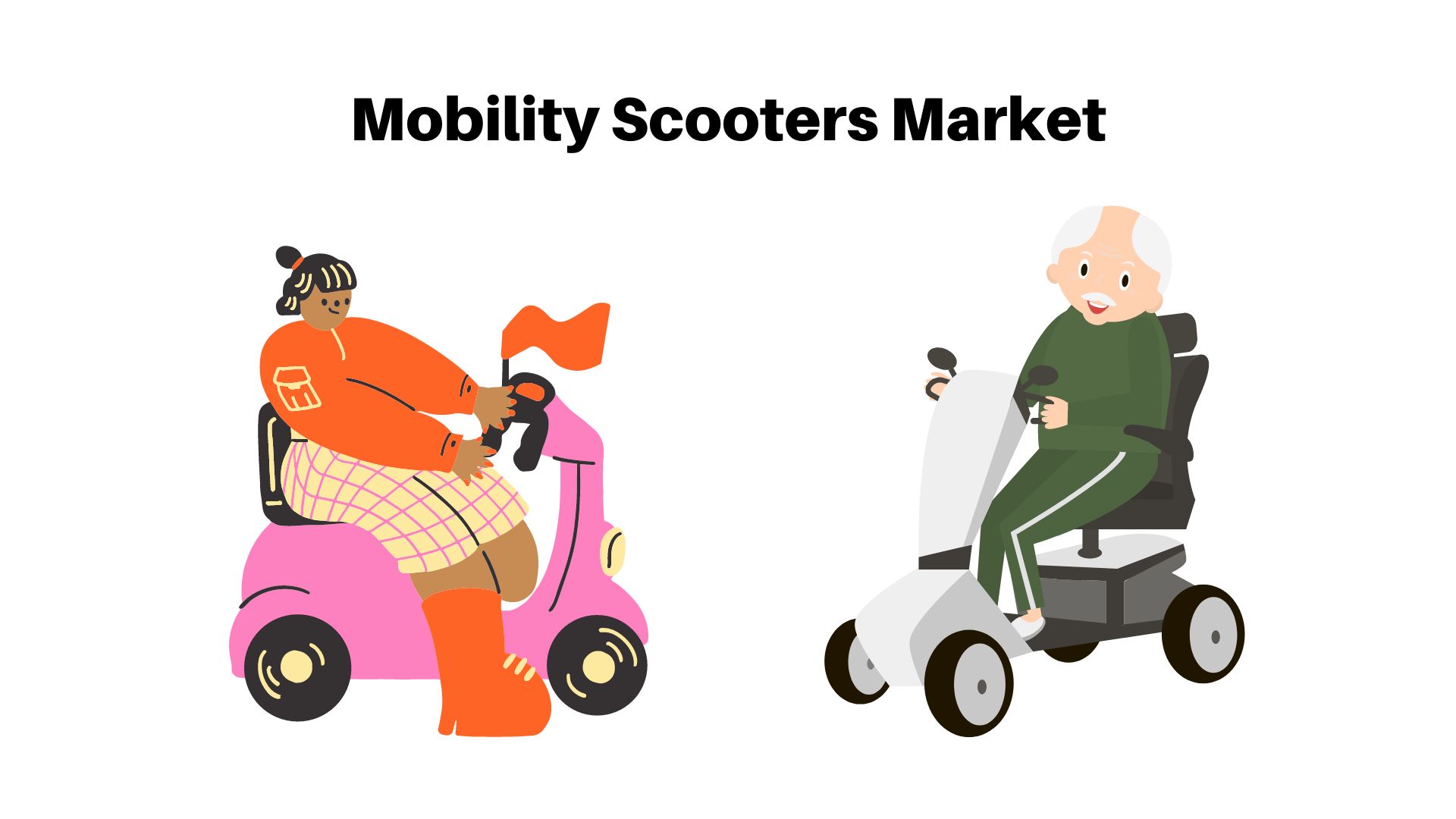Mobility Scooters Market Sales to Top USD 3.94 Bn by 2032 | CAGR of 7.5%

Page Contents
Published Via 11Press: In 2022, the global mobility scooters market size was valued at USD 1.91 billion and is projected to expand at a compound annual growth rate (CAGR) of 7.5% from 2022-2032.
Mobility scooters are electrically-powered vehicles designed for people who have difficulty walking or moving due to disabilities or age-related conditions. They're often found in homes, public places, and healthcare facilities so those with limited mobility can move around more freely and independently.
The market growth is being spurred on by factors such as an increasing number of people with mobility impairments due to aging populations, rising prevalence of chronic conditions like arthritis, and technological advances in mobility scooters. Furthermore, increased government support for mobility aids through subsidies and tax incentives is fuelling this growth trend.
Request For Sample Report Here | https://market.us/report/mobility-scooters-market/request-sample
Key Takeaways:
- Growing Aging Population: The global aging population is one of the major drivers of the mobility scooters market. As people get older, they become more likely to experience mobility impairments and may need assistance such as scooters to maintain their independence and freedom.
- Rising Prevalence of Chronic Conditions: Chronic conditions like arthritis and multiple sclerosis are becoming more commonplace worldwide, prompting an uptick in demand for mobility scooters. These illnesses can cause significant impairment to mobility, making it difficult for individuals to move around independently.
- Technological Advancements: Technological advancements in mobility scooters are fueling market growth, with features such as longer battery life, improved safety and superior maneuverability making these products increasingly appealing to consumers.
- Government Support: Governments around the world are providing subsidies and tax incentives for mobility aids such as scooters to make them more affordable for individuals with mobility impairments. This has spurred market growth by increasing accessibility to these products.
- 4-wheel Scooters Reign Supreme: Four-wheel mobility scooters are the most popular type of mobility scooter, accounting for the largest market share. This popularity can be attributed to their stability and weight capacity which make them suitable for a variety of users.

Regional Snapshot
- North America: North America dominated the global mobility scooters market in 2020 and is forecast to maintain its dominance throughout the forecast period. The region boasts a well-established healthcare infrastructure as well as an aging population with high prevalence of mobility impairments, fueling market growth.
- Europe: Europe is a major market for mobility scooters, with countries like the UK, Germany and France accounting for much of the share. Due to a high prevalence of chronic illnesses like arthritis in this region, demand is expected to be particularly strong for mobility aids.
- Asia Pacific: The Asia Pacific region is expected to experience the highest compound annual growth rate over the forecast period due to an aging population and rising healthcare expenditure in this region. Countries such as Japan, China, and India boast large aging populations which is fueling demand for mobility scooters.
- Middle East and Africa: The Middle East and Africa region is expected to experience moderate growth over the forecast period due to an increasing prevalence of chronic conditions and an increasing need for healthcare services.
- Latin America: Latin America is expected to experience moderate growth in the mobility scooters market due to an increasing prevalence of chronic illnesses and an aging population in the region.
Drivers
- Growing Aging Population: As the global population ages, mobility impairments are on the rise; this will continue to be one of the primary drivers for market growth in this space. Scooters and other mobility aids such as walkers are expected to become even more prevalent due to this growing geriatric population.
- Increased Prevalence of Chronic Conditions: Chronic illnesses such as arthritis, multiple sclerosis and Parkinson's disease are becoming more widespread worldwide, leading to an increase in mobility impairments. This has spurred demand for mobility aids such as scooters to help individuals maintain their independence and independence.
- Technological Advancements: Technological advancements in mobility scooters are fueling market growth, with features such as extended battery life, enhanced safety and better maneuverability making these products increasingly appealing to consumers.
- Government Support: Governments around the world are providing subsidies and tax incentives for mobility aids such as scooters to make them more affordable for people with mobility impairments. This has resulted in increased access to these products, fuelling market growth.
- Increased Awareness: As more people become educated on mobility impairments and the advantages of mobility aids, more are likely to invest in scooters to maintain their independence and freedom of movement.
Restraints
- High Cost: Mobility scooters can be expensive, especially those with advanced features like extended battery life and improved maneuverability. This may make them inaccessible for people with mobility impairments who may have limited financial resources.
- Limited Access in Developing Regions: Mobility scooters may not be readily available or affordable in developing regions where mobility impairments are common. This could limit market growth in these regions.
- Lack of Awareness: Despite growing awareness about mobility impairments and the advantages of mobility aids, some individuals may still lack insight. This could be a factor in limiting market expansion opportunities.
- Safety Concerns: Mobility scooters pose safety risks when used in crowded places like sidewalks and shopping centers. This may deter some individuals from investing in these products.
- Maintenance and repair expenses: Mobility scooters require regular upkeep and repair, which can be expensive and time-consuming for some consumers. This may deter some individuals from investing in these products or restrict their usage.
Opportunities
- Technological Advancements: Technological advancements such as lightweight materials, improved battery life and advanced safety features provide mobility scooter manufacturers with opportunities to develop innovative products and attract more consumers.
- Enhancing Customization: As demand for mobility scooters continues to rise, manufacturers may have the chance to create products that cater specifically to individual consumers' needs and preferences.
- E-Commerce: The growth of e-commerce presents mobility scooter manufacturers with an opportunity to reach a wider audience and diversify their customer base beyond traditional brick-and-mortar stores.
- Growth in Tourism Industry: As tourism expands across many regions, mobility scooter manufacturers can take advantage of this trend to reach out to travelers with mobility impairments who require temporary assistance for transportation.
- Government Initiatives: Government initiatives such as subsidies and tax incentives can offer manufacturers an avenue to expand their market reach, making mobility scooters more accessible to a broader range of buyers.
Challenges
- Regulatory Challenges: Regulations related to mobility scooters can differ by region, creating difficulties for manufacturers and retailers in navigating various requirements and standards.
- Limited Accessibility: In some regions, infrastructure and accessibility may be lacking, making it difficult for individuals with mobility impairments to use mobility scooters efficiently.
- Negative Perceptions: Some individuals may hold negative attitudes towards mobility scooters and view them as a sign of weakness or dependence. This could create an unfavorable social stigma which discourages some from investing in these products.
- Limited Insurance Coverage: Many insurance plans may not cover the cost of mobility scooters, making them inaccessible to individuals with mobility impairments who may have limited financial resources.
- Limited Access to Replacement Parts: Mobility scooters may need replacement parts over time, and in certain regions it can be difficult to locate replacements or repair services. This poses a problem for consumers when trying to maintain their mobility aids.
Request For Sample Report Here | https://market.us/report/mobility-scooters-market/#inquiry
Recent Developments
- Innovative Designs: Mobility scooter manufacturers are creating cutting-edge designs to attract consumers. For instance, some are creating foldable scooters which make transporting them a breeze, while others add advanced safety components like automatic braking systems for added peace of mind.
- Increased use of lightweight materials: Many manufacturers are now incorporating lightweight elements like carbon fiber and aluminum into their designs, making mobility scooters lighter in weight and easier to manoeuvre.
Key Market Segments
Type
- 3-wheeler
- 4-wheeler
- 5-wheeler
Application
- In door
- Out door
Key Market Players
- Quingo
- Invacare
- Drive medical
- Pride Mobility Products
- Electric Mobility
- Afikim Electric Vehicles
- Amigo Mobility International
- Golden Technologies
- Hoveround
- KYMCO
- Merits Health
- Sunrise Medical
- TGA Mobility
Report Scope
| Report Attribute | Details |
| The market size value in 2022 | USD 1.91 Bn |
| Revenue forecast by 2032 | USD 3.94 Bn |
| Growth Rate | CAGR Of 7.5% |
| Regions Covered | North America, Europe, Asia Pacific, Latin America, and Middle East & Africa, and Rest of the World |
| Historical Years | 2017-2022 |
| Base Year | 2022 |
| Estimated Year | 2023 |
| Short-Term Projection Year | 2028 |
| Long-Term Projected Year | 2032 |
Frequently Asked Question
Q: What is the current market size for the Mobility Scooters Market?
A: According to a report by Market.us, the Mobility Scooters Market was valued at USD 1.91 billion in 2022 and is expected to reach USD 3.94 billion by 2032, growing at a CAGR of 7.5% during the forecast period.
Q: What are the key segments of the Mobility Scooters Market?
A: The Mobility Scooters Market can be segmented based on By Type (3-wheeler, 4-wheeler, 5-wheeler), By Application (In door, Out door), and geography (North America, Europe, Asia-Pacific, Latin America, and Middle East & Africa).
Q: Who are the key players in the Mobility Scooters Market?
A: Some of the key players in the Mobility Scooters Market include Quingo, Invacare, Drive medical, Pride Mobility Products, Electric Mobility, Afikim Electric Vehicles, Amigo Mobility International, Golden Technologies, Hoveround, KYMCO, Merits Health, Sunrise Medical, TGA Mobility.
The team behind market.us, marketresearch.biz, market.biz and more. Our purpose is to keep our customers ahead of the game with regard to the markets. They may fluctuate up or down, but we will help you to stay ahead of the curve in these market fluctuations. Our consistent growth and ability to deliver in-depth analyses and market insight has engaged genuine market players. They have faith in us to offer the data and information they require to make balanced and decisive marketing decisions.


